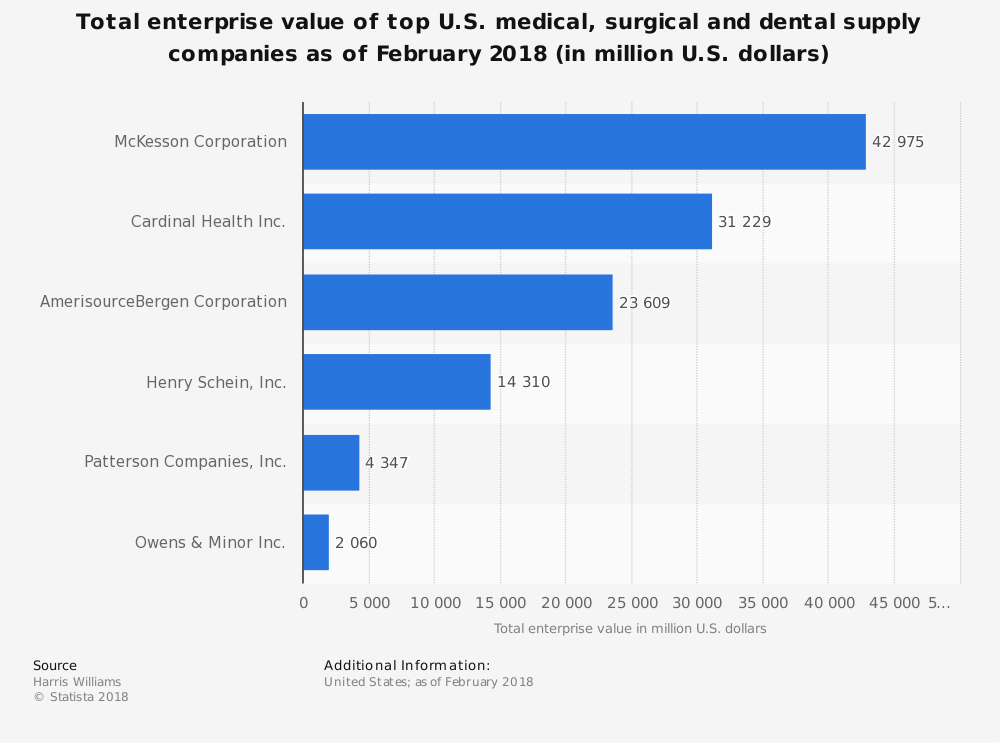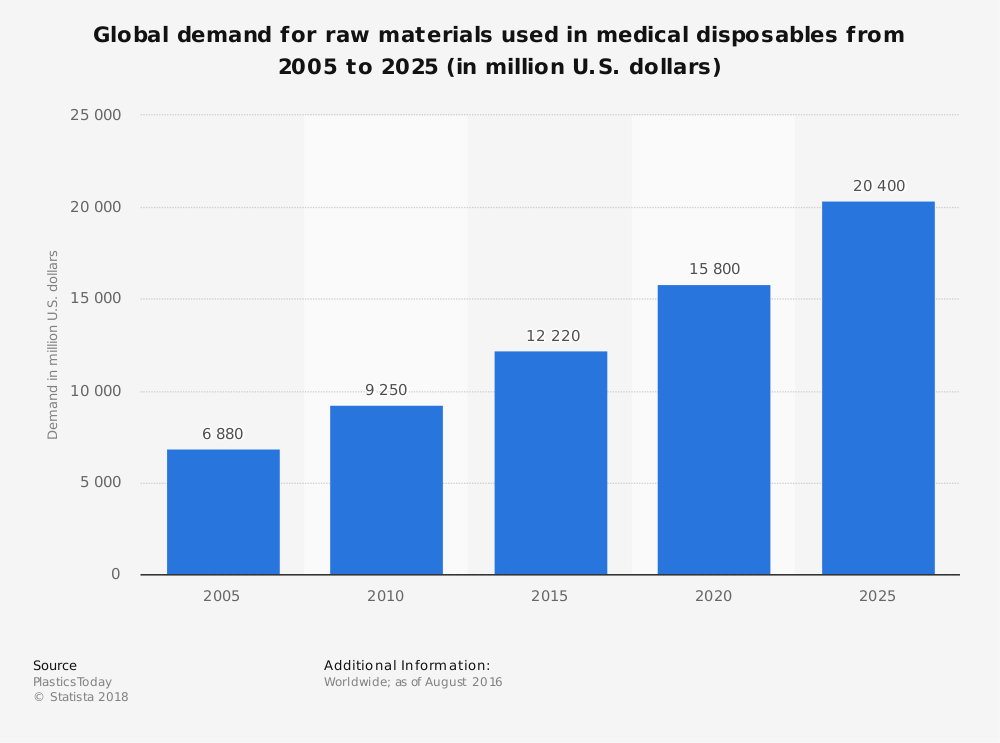The medical supplies industry is generally grouped into two categories: invasive medical supplies and non-invasive medical supplies.
Invasive medical supplies are items that would usually be required to perform a surgery. They are items which break the skin to provide a specific service. They come into contact with the internal body cavity in some way or the mucous membrane to deliver services.
Non-invasive medical supplies do the opposite. They deliver services without making contact with the body unless it is through a natural or artificial body orifice. An x-ray machine, radiation therapy, and defibrillation are all examples of non-invasive medical supplies.
Important Medical Supply Industry Statistics
#1. The total revenues generated by the overall medical supply industry annually in the United States are valued at $192 billion. From 2012-2017, the wholesaling industry for medical supplies grew at an annualized rate of 1.7%. (IBIS World)
#2. About 13,000 firms are currently active in the medical supply industry within the United States right now. These firms are responsible for the employment of more than 220,000 people. (IBIS World)

#3. The total value of surgical and medical instrument manufacturing shipments in the United States is valued at $38.4 billion. (Statista)
#4. The global value of the medical supply industry in 2016 was estimated to be $387 billion. Total growth in the technology field within this industry was 4.2% in 2016. (Statista)
#5. In 2016, firms in the U.S. spent $26.7 billion on research and development within the technology segment of this industry. As a percentage of the total revenues generated, about 7% of spending within the industry is directed toward research and development activities. (Statista)
#6. There are currently 5 medical technology firms that make at least $5 billion in revenues each year, but less than $10 billion. Optum, which is based in the United States, reported revenues of $7.3 billion in 2015. In 2017, revenue from the Fresenius Group was reportedly EUR33.9 billion. (Statista)
#7. In 2016, in-vitro diagnostics equipment made up 12.8% of the medical technology market. (Statista)
#8. Owens and Minor supply almost 220,000 brand-name surgical and medical supplies to hospitals and acute care facilities each year. (Value Line)
#9. Johnson and Johnson generates 40% of its total sales each year from diagnostic products. (Value Line)
#10. The durable medical equipment segment in the United States has an estimated value of $41.9 billion. Over the next 10 years, this segment of the industry is forecast to grow with a CAGR of 6%. (Grand View Research)

#11. Monitoring and therapeutic devices comprise a vast majority of the sales produced by the medical supply each year. This segment generates 85% of the total product sales created by the industry each year. (Grand View Research)
#12. When all facets of the medical supply industry are evaluated, there are a total of 305,000 direct employment opportunities available in the United States. The employment RSE for the industry is listed at 1.9%. (Bureau of Labor Statistics)
#13. The median hourly wage for someone with direct employment in the medical supply industry is $20.12 per hour. Wages within this industry have been growing at 1% annually. (Bureau of Labor Statistics)
#14. For the medical supply industry, the U.S. market represents 45% of the global sales that are generated each year. (Market Realist)
#15. General Electric has the highest market capitalization value in the U.S. medical supply industry today, at $278.66 billion. Johnson and Johnson comes in a close second, with a market cap of $261.76 billion. Medtronic is the only other company in the U.S. that has a market cap over $100 billion. (Market Realist)
#16. In Canada, there are 2,395 business currently listed within the medical equipment and supplies manufacturing industry. 97.9% of these firms employ 99 people are fewer. (Statistics Canada)
#17. The average revenues generated by a firm in Canada focused on medical equipment and supplies manufacturing are $630,000. About 78% of the businesses currently active in this segment are listed as being profitable as of 2015. (Statistics Canada)
#18. In total, manufacturing in Canada within this industry creates $3.3 billion in shipments each year. This contributes a value-added $2 billion to the economy and $420.6 million in net revenues. (Statistics Canada)
#19. The Canadian medical supplies industry imports $6.7 billion worth of goods each year, with a majority of the supplies coming from the United States. The industry also exports about $1.7 billion in products each year. (Statistics Canada)
Medical Supply Industry Trends and Analysis
Innovation is what drives the medical supply industry forward. There will always be a need to treat people. The supplies offered by this industry make that possible in a variety of settings. From hospital stays to at-home care, the products which provide comfort and care are created by this industry.
As the developing world grows in wealth and requires greater access to medical care, this industry should experience global growth in the next 10 years. The mature markets, such as North America and Europe, will see demand levels remain stable. An innovative breakthrough, however, could push revenues much higher for the company responsible for new technologies, which would also help the overall industry.
Opportunities for growth in this sector also come from an aging population, which may reach 80 million people above the age of 65 by the year 2050. Cancer accounts for 13% of deaths globally each year and cancer diagnosis rates are expected to increase by 70% through 2035.
There are regulatory concerns which may limit the growth of medical supplies in certain fields. Product approvals are based on acceptable risk factors. If fewer items are approved for use or sale, this industry could see reduced revenue levels compared to what they currently generate.
Although millions of people visit Brandon's blog each month, his path to success was not easy. Go here to read his incredible story, "From Disabled and $500k in Debt to a Pro Blogger with 5 Million Monthly Visitors." If you want to send Brandon a quick message, then visit his contact page here. Brandon is currently the CEO of Aided.
